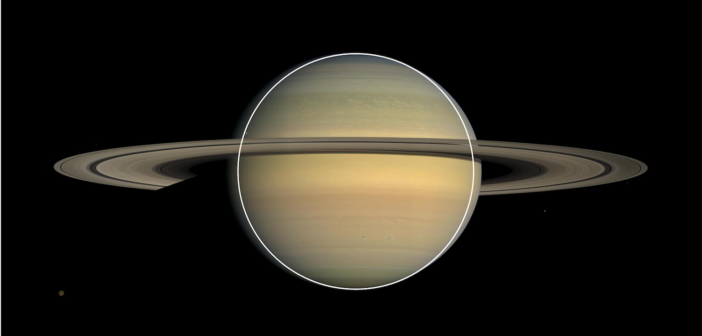Editor’s Note: Astrobites is a graduate-student-run organization that digests astrophysical literature for undergraduate students. As part of the partnership between the AAS and astrobites, we occasionally repost astrobites content here at AAS Nova. We hope you enjoy this post from astrobites; the original can be viewed at astrobites.org.
Title: On The Effects of Planetary Oblateness on Exoplanet Studies
Authors: David Berardo and Julien de Wit
First Author’s Institution: Massachusetts Institute of Technology
Status: Published in ApJ
The world is a complicated place, and all scientists are just storytellers trying their best to explain it with more and more accurate fables. One of their most commonly accepted tropes in the canon of physics is assuming that anything round-ish, even a cow, is a perfect sphere. Astronomers implicitly do this all the time when it comes to exoplanets: we assume that all of them, big and small, hot and cold, are immaculate orbs.
Even in our own solar system, though, we know that this is not strictly true. Consider the hypothetical cosmic prospector: if they wanted to drill a hole to the center of Saturn, they’d better carefully consider their starting location. If they broke “ground” on the equator, they’d have to dig about 10% farther than if they had started from the north pole (setting aside the difficulties of “digging” through a gas giant). This is because Saturn is slightly squashed: its equatorial radius is larger than its polar radius, and it bulges out in the middle due to its rapid rotation.
Even though our investigations of worlds beyond our neighborhood have turned up strange and unexpected systems wholly different from our own, we have no reason to assume that there wouldn’t be similarly squished planets out there. Today’s authors take that tension between our simple models and expectation of non-spherical planets and answer two resulting questions: can we do better and actually measure a planet’s bulge, and, if not, what are the implications of using the wrong model?
Can We Detect It?

Figure 1: The difference in the area of the star blocked by a spherical planet and an oblate planet. Note that as the oblate planet crosses the stellar limbs, it blocks different amounts of stellar area than a spherical planet would. The bigger this difference is, the easier it would be to detect that a planet is oblate. [Adapted from Berardo and de Wit 2022]
To assign a quantitative measure of this difference, the authors created fake data of oblate and spherical planets passing in front of their stars, zoomed in on just the beginning and end of the transits, then measured the root mean square of the difference between the two types of planets. They found that this value depends strongly on the cadence, or amount of time between measurements, of their fake data. This is illustrated in Figure 2. All told, they estimate that several tens of currently known planets would differ from a spherical model by a few tens of parts per million if they were actually oblate.

Figure 2: The number of known planets (y axis) that would differ from a spherical model by a given amount (x axis) if they all actually had an oblateness of 0.2. Note that shorter-cadence data can reveal more oblate planets than longer-cadence data. This is because the authors focus only on the ingress/egress of the planet, and shorter-cadence data allows for more measurements during that time. [Adapted from Berardo and de Wit 2022]
How Wrong Is Circular?
If we can’t really measure the oblateness of a moderately squished planet, does it even matter?
Unfortunately, the authors show that it might. Much like a slightly square peg can still be jammed through a round hole, we can still fit an oblate light curve with a circular model, but it won’t be a great match. Our estimates for many of the model parameters will be biased — that is, they’ll lean away from their true value in a given direction. For example, in Section 3 of the research article, the authors show that we’re likely to underestimate the true radius of a planet and overestimate its inclination.
This is unfortunate, but it’s important when we consider the downstream effects of how we use these transit-derived parameters to construct other descriptions of a planet. Astronomers have measured the masses and radii of a growing number of planets using the transit technique and by careful monitoring of the host star’s radial velocity, respectively. It is tempting to combine these measurements into an estimate of the density of the planet, but doing so requires assuming the volume of the planet. This requires assuming the planet is spherical, or at least that your measured radius is correct. If either of those are false, your final density will be incorrect. The authors estimate that available data can only rule out oblateness over about 0.25, but if that planet was even slightly rounder than that, we’d get its density wrong by more than 10%.
It’s nice to pretend that all cows are spheres. But we learn a lot, and can be more honest about the accuracy of our measurements, when we consider that some planets might be more complicated than we’d wish.
Original astrobite edited by Lili Alderson.
About the author, Ben Cassese:
I am a second-year Astronomy PhD student at Columbia University working on simulated observations of exomoons. Prior to joining the Cool Worlds Lab I studied Planetary Science and History at Caltech, and before that I grew up in Rhode Island. In my free time I enjoy backpacking, spending too much effort on making coffee, and daydreaming about adopting a dog in my NYC apartment.
